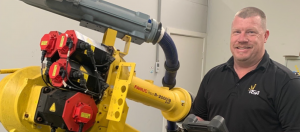
Michael “Spoggy” Sparrow joined the ASA team in April of 2015, having previously worked with a number of different robots during this 12 years at GM Holden in Elizabeth, where he worked as a Die Machinist and Tool Technician. Michael came very highly recommended to the ASA team, and quickly adapted his robot experience to FANUC paint robots. Since 2015, he has been a much loved member of the ASA team, where he has functioned in the role of a Paint Process Engineer. We look the time to talk to Michael, and ask him some questions about his time with ASA.
What has been your favourite robot to work with?
The P700 Paint Robot. It’s flexibility enables it to be used for interior or exterior applications and by having the rail for the robot to move along means that the robot is playing in the same orientation regardless of where it is in the booth, which as a paint programmer, makes things much simpler.
What’s been your most interesting project?
Working at a plant in South Korea would definitely rank up there as the most challenging and interesting. We were programming changes across two production lines using a combination of rotary atomisers (bells) and TRP gun applicators, so the vehicle may have been common, but the paths were very different. Added to that complexity was the number of styles, which was significantly more than you’d experience as a model mix in any automotive assembly plant. This, coupled with the fact that one line was was continuously moving (line tracking), while the other was an indexing stop station, meant that we were using just about every programming skill at our dispose to make this combination of paths. Both lines required a very specific and thorough approach to ensure the correct film build thickness and quality standards were achieved across multiple colours, so the project was a great success, but it certainly required the broadest application of skill sets I’ve encountered.
What’s been your biggest challenge you’ve had to overcome on a project?
Working on a project after other functional groups have already demobilised and addressing customer concerns may be challenging, but also extremely gratifying. I appreciate knowing how to listen to client problems, being honest and forthright with them, and reassuring them that we would help them handle the issues. You may not have the immediate expertise to handle these issues, but it is simply a matter of knowing who to contact so they can do so and pass the information back to you for implementation on-site. When this occurs in a location where English is not the native tongue, the language and cultural barrier makes these tasks exponentially more difficult, but also more rewarding and gratifying when we get the end result we are all looking for.
What do you enjoy most about working at ASA? (Best part of your job?)
The chance to collaborate with and assist various company divisions. At any moment, I may be involved in process and robot programming, electrical and safety systems design, installation, and commissioning. You can have clean hands and be working on your laptop in the office one minute, then be in the workshop disassembling a robot the next!
What has been your biggest achievement to date?
For me, it’s always gratifying to be requested by name for future upgrades and installations by customers. Being able to maintain a good rapport with the customer and collaborating with them to achieve successful new installations and upgrades to meet and deliver to their expectations is key. Maintaining a positive relationship with customers and cooperating with them, and seeing those customers go on to become repeat customers, because you not only met, but exceeded their expectations, is always for me my biggest achievement.
What does a typical day look like for you and what are you currently working on?
Currently I am working on offline projects for paint and sealer applications to be used onsite by various car manufacturers all over the world, and I’m doing it all out of our office here in Adelaide. This involves working office type hours, whilst communicating effectively with other members of the team who are also assisting with these tasks, but may be in another country. This work is challenging and has to be meticulous, so these programs can drop into customer sites seamlessly.
Three words to describe your role?
Varied, Challenging, Meticulous
Send an enquiry:
Click an Application to Explore Further:
FANUC Robots Australia | Paint Robots for Surface Finishing | Welding Robots by FANUC | Machine Tool Tending Robots | Fibreglass and Gelcoat Robots | Palletising Robots | Robotic Vision Inspection Systems | Plastics Painting | Deburring and Polishing | Sealing and Dispensing | Picking and Packaging | Material Removal Robots | Shot Blasting and Peening |
More (Recent) News Stories from Automation Solutions Australia:
Deburring Machines | Robots a Historical Overview | Robotics Engineering | Automatic Paint | Robotic Loading Systems for CNC | Unlocking Your Manufacturing Potential | Spray Painting Robots | Automatic Sandblasting | CNC Mills | Automated Welding | Unlock the Future with Automation Systems | Robot Company, The Automation Era | Choosing an Automation Company | Harness the Power of Robotics with ASA | Robotic Painting | Automotive Welding | The Path to Machine Tool Automation | System Integrator Australia | Robotic Welders | Automate your CNC | Automation Company | Electrical Design | Human Machine Interface | Plastic Paint Robots | PLC Programming | Robotics Australia | Solutions | Industrial/Manufacturing Robots | Industrial Engineering | FANUC Robot | Shot Blasting | Robotic Automation Solutions | Industrial Automation | FANUC Industrial Robots | FANUC Collaborative Robots | FANUC Palletising Robots | Robotic Palletisers | Robotic Fibreglass Spray Machines | CNC Machine Automation | Robotic Arm – An Industry Guide | The Cobot | Automation Robotics | Custom Automation Solutions | Assembly Robots | Automate your Paint Booth | Ceramic Coating – Cerakote | Automotive Automation | Pick and Place Robots | Understanding Industrial Automation | PLC Automation | Arc V Spot Welding | What is Cerakote? | CNC Machines Australia | What is a Robotic Cell | Robotics Systems with ASA | What is ARC Welding? |PLC Controls | Collaborative Robots – What are they? | Welding Automation |


